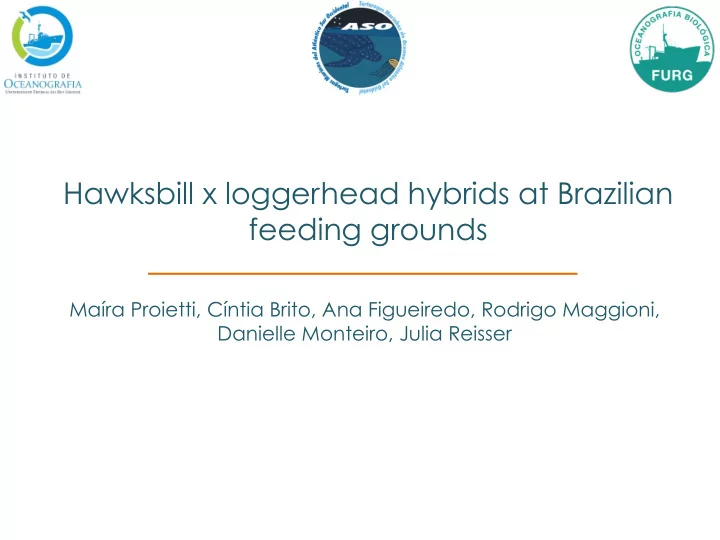

Hawksbill x loggerhead hybrids at Brazilian feeding grounds Maíra Proietti, Cíntia Brito, Ana Figueiredo, Rodrigo Maggioni, Danielle Monteiro, Julia Reisser
Background • Five sea turtle species occur in Brazil Dermocheliidae Cheloniidae Photos: Projeto Tamar
• Threats include poaching, habitat loss/alteration, bycatch, and marine debris
Background • Hybridization: possible threat to Brazilian sea turtles? • Hybridization between Cheloniids has been reported worldwide Photos: Projeto Tamar
Background Reis et al. 2010 • Brazil: very high rates in BA/SE Possible causes: large pop. • 27% reductions, spatial-temporal overlap, skewed sex ratios SE ¡ • Consequences? BA ¡ Lara-Ruiz et al. 2006 42%
Background • Bahia rookery: 42% “hawksbill” females are hybrids mtDNA Morphology X ¡ Lara-Ruiz et. al. 2006
Background • Female hybrids lay viable eggs Morfology mtDNA X = Until recently, no observation of immature hybrids from BA at FGs
To fill this gap Skin samples - 224 immature hawksbills n=12 n=56 800 bp mtDNA D-loop n=55 (Abreu-Gobrois et al. 2006) n=72 Amplification/sequencing Sequence analysis/ n=6 haplotype id Blumenthal ¡et ¡al. ¡2009 ¡ n=24
Results • Eight turtles (37 to 52 cm CCL): Hawksbill morphology but ¡ Loggerhead mtDNA (Bahia haplotype) ¡ CC-A4 ¡
Results ¡ ¡ Núcleo de Educação e Monitoramento Ambiental
Results Immature hybrid distribution ¡ ¡ CE: 1/56 BA: 1/55 BA ¡ RS: 6/24
Results • Dispersal to the South – favored by currents? ¡ ¡ BA ¡ RS: 6/24
Results Particle dispersal model (ICHTHYOP 3.2) • ¡ ¡ 3 simulations according to peak hatching period • Temporal overlap, but slightly distinct peaks • Jan Mar Apr Nov May Loggerheads Hybrids Hawksbills
Loggerheads – 72% S ¡ ¡ Hybrids – 44% S Hawksbills – 36% S Proietti et al. 2014
Results • Dispersal to the South – ecological/behavioral? Loggerhead: Hawksbill: Wider distribution Tropical, coastal High occurrence in South BR Not common in South BR seaturtleexploration.com
Next steps ¡ Morphology mtDNA ¡ X ¡ • Until now: only mtDNA Allows hybrid detection only when morphology/mtDNA are different
Next steps ¡ nDNA analyses ¡ (markers described by Vilaça et al. 2012) Can detect hybrids even Provides more info – parental when morphology and species, generations, signs of mtDNA are the same introgression Additional sampling (more coverage!)
What we expect... • Increase the detection of immature hybrid turtles in Brazil; • Better understand the distribution patterns of hybrids along the coast; • Evaluate the characteristics of this hybridization (generations, parental species); • Collaborate with other projects studying hybrids to help diagnose the effects of hybridization on endangered sea turtle species in Brazil.
Partners and sponsors: Part of the results published in “Hawksbill x loggerhead hybrids in Bahi, Brazil: where do their offspring go?” (PeerJ 2014) mairaproietti@gmail.com
Recommend
More recommend